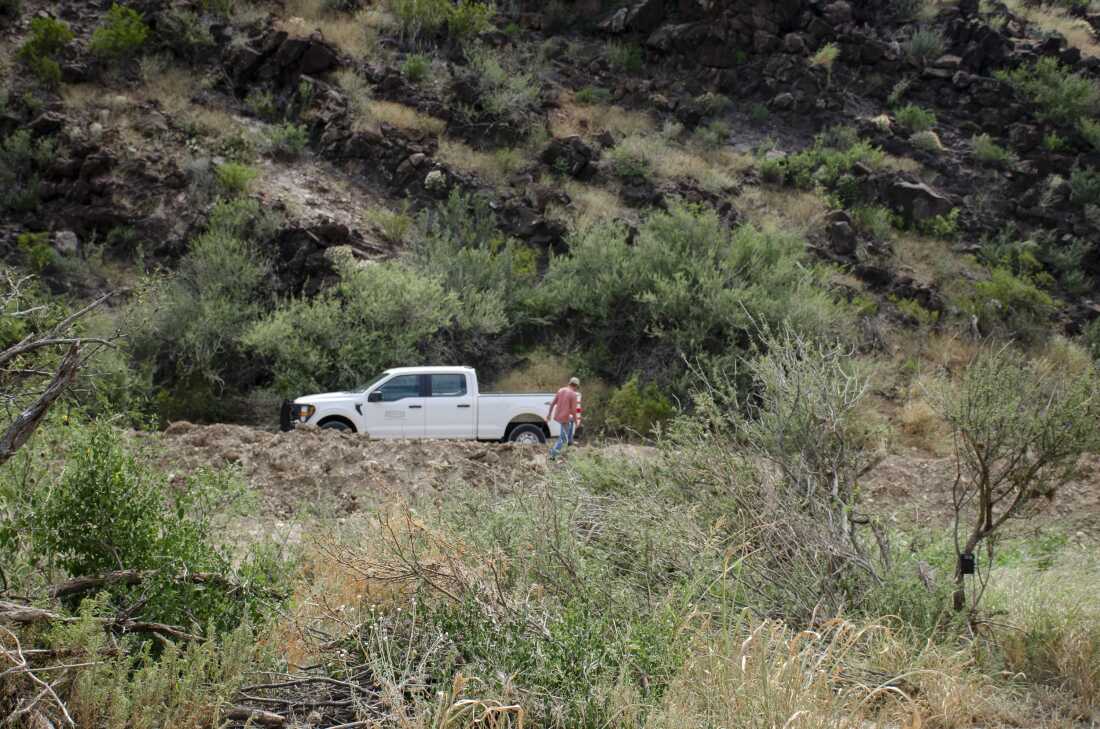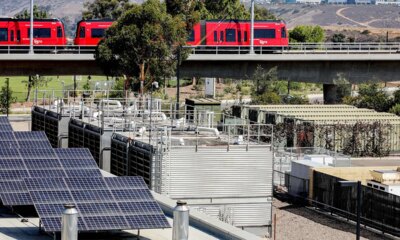News
A Scenic California Rail Line Sits on an Eroding Cliff. Where Should the Tracks Go?

Perched atop craggy bluffs in a beachside city north of San Diego, a railroad line offers passengers a sweeping view of the Pacific Coast. But the ground beneath it is crumbling.
No one denies the problem, but a fight over how to solve it highlights a broader challenge, and a worrisome reality, for California residents: how to adapt to climate change that threatens coastal living, a way of life that has long defined the state’s identity, from its economy to its culture.
The segment of track on the bluffs in Del Mar, Calif., connects San Diego to the rest of the state and the country, and is part of one of the busiest intercity passenger rail corridors in the nation. But the bluffs are eroding rapidly, and the track in some places is now only a few yards from the cliff edge.
Officials and residents in Del Mar and nearby communities broadly agree that the tracks need to be moved, but argue over where they should go. The debate has slowed progress, even as climate change accelerates the risks to the bluffs and the rail line.
On Friday, local representatives on the board of the county’s regional planning agency — the San Diego Association of Governments — voted to narrow the potential alternatives to four options, down from more than a dozen that were assessed in a recent report. But a final decision remains far off.
“It’s at a dangerous point, and with all the bureaucracy involved, it makes us wonder whether it will even be in our lifetime before it’s solved,” Barbara Myers, a former Del Mar school board member, said of the problem. She lives near the proposed location of a tunnel entrance to relocate the rail line, and she worries about toxic fumes or the possibility of street collapses.
With sea levels rising and stronger waves battering their shores, many other communities like Del Mar see a need to adapt, but are finding the options difficult.
Cliffside homes and apartment buildings teeter on the edge, some of them abandoned or demolished preemptively because of the threat of collapse from erosion. Infrastructure has taken a beating up and down the California coast: Sections of scenic Highway 1 have closed repeatedly because of landslides, and the Santa Cruz Wharf, a popular tourist attraction, was torn apart by towering waves in December. Communities are racing to protect shrinking beaches, reinforcing them with barriers and dredging sand from other areas in an effort to maintain and replenish them.
“The situation in Del Mar is a microcosm of a larger battle that’s unfolding,” said Charles Lester, a former official with the California Coastal Commission, a state agency that manages development along the coastline. He now directs the Ocean and Coastal Policy Center at the University of California, Santa Barbara. “What are we going to prioritize and try to maintain as these environmental changes happen?”
The Del Mar track is part of a 351-mile coastal rail corridor stretching from San Luis Obispo to San Diego. It is used by passenger, freight and military trains, including Amtrak’s Pacific Surfliner, whose name evokes the way sections of the route hug the coast. Millions of trips are taken along the route each year.
But the same coastal proximity that gives passengers scenic ocean views also makes the track vulnerable to erosion. Construction crews are now working on the fifth project since the early 2000s to stabilize the Del Mar bluffs, a $90 million effort that will, among other things, install additional support columns and retaining walls.
These projects are not a long-term solution. The rising ocean and erosion continue to pound the bluffs, leading to costly emergency repairs and repeated service disruptions. On average, the bluffs retreat a few inches a year, but there can be sudden collapses that chew away more than 20 feet at once. And not just in Del Mar: Erosion is also destabilizing parts of the rail corridor farther north, in San Clemente.
“Realistically, time is not on our side, with the acceleration of climate change,” said Fred Jung, who chairs the rail corridor’s board of directors. “We are forced to act right now.
City officials in Del Mar — a community of about 4,000 residents in an area of less than two square miles — have been talking for decades about moving the tracks off the crumbling bluffs. In 2017, the county planning agency completed a study outlining five possible new routes.
The idea gained momentum in 2022 when Gov. Gavin Newsom signed a state budget that allocated $300 million for relocating the tracks. In June 2024, the association of local governments announced that it had narrowed the options down to three, all involving inland tunnels.
The reaction was swift. Del Mar residents raised concerns about tunnel construction and operations beneath their homes, citing risks from vibration and pollution. People who lived near the entrance and exit points of the proposed tunnels worried that homes would be demolished.
A proposed route running through a lagoon was opposed by environmentalists because of how it might affect sensitive habitats. A route that would tunnel under the San Diego County Fair grounds and into neighboring Solana Beach met resistance from that city and from fair organizers.
And looming above the debate is the question of money. The project is expected to cost billions of dollars, and county voters rejected a half-cent sales tax increase in November that would have raised money for regional transportation and infrastructure projects, including the Del Mar track relocation.
In light of all that, the agency re-examined the issue, ultimately leading to the vote on Friday. Three of the options now on the table would move the line off the bluffs; a fourth would keep the track where it is, reinforce the bluffs and add a second track next to the existing one.
As required by state and federal law, the agency would also study a fifth option: no project at all.
The meeting, with two hours of discussion, grew emotional at times, as officials and residents voiced concerns about the proposed options. Mayor Terry Gaasterland of Del Mar abstained from voting.
The mayor said in an interview before the meeting that none of the remaining options is likely to satisfy everyone.
“We’re going to need to step back and minimize the sum total of the unhappiness,” she said. “And also spread it out.”
That debate was on display on a recent Saturday in Del Mar, as construction crews were working to stabilize a section of the bluffs supporting the tracks. Near the top, workers used excavators, a giant drill and other heavy equipment. In several areas, chunks of the bluffs had eroded and crumbled, sending dirt, rocks and vegetation tumbling down onto the beach.
Officials acknowledge that neither the current stabilization project nor emergency repairs offer a long-term solution to the challenges of the rising ocean and coastal erosion.
Jim Hindman, 64, a financial consultant, lives with his family just one house away from the bluff-top tracks. His voice was sometimes drowned out by the construction trucks that kicked up dust as they pulled in and out of his street, which ends at the tracks.
Mr. Hindman said the option to add a second track to the existing rail line would alter the character of his neighborhood and the bluff. He said the bluffs were a beloved community space where people gather to watch sunsets, spot whales and dolphins, and even celebrate weddings.
“Tranquillity by the sea? Not happening for the next couple of years,” he said, referring to the stabilization work and the potential for a tunnel project to follow.
Richard Sfeir, 66, has lived for three decades in Del Mar Heights, a San Diego neighborhood bordering the city of Del Mar. Many houses in the Heights perch high above downtown Del Mar along narrow, winding streets. One relocation proposal would route the tracks through a tunnel under the neighborhood, an idea that he called “crazy” because of its cost, timeline and impact on a protected environmental area.
But Mr. Sfeir, a businessman, said that something needed to be done.
“No solution is not an answer,” he said, “unless you get rid of the train, period.”

News
Black bear populations are bouncing back. Here’s how these Texas towns are coping

Ken Clouse and his wife Pam look at a still image taken from a game camera on their porch. The couple says in the last two years, they’ve regularly seen black bears in their neighborhood south of Alpine, Texas.
Carlos Morales/NPR
hide caption
toggle caption
Carlos Morales/NPR
ALPINE, Texas — In one of the most remote corners of Texas, Matt Hewitt is unlocking the door to a giant steel trap he’s hoping will catch a black bear.
“It’s completely empty,” Hewitt says, as he reaches for a bucket with bait – days-old glazed donuts and frozen cantaloupe.
Hewitt, a researcher at the Borderlands Research Institute, affiliated with Sul Ross State University, leads a group that captures and collars black bears to try and get an idea of just how many are roaming the mountains and desert stretches of Far West Texas. And although it’s too soon to say exactly how many bears there are, Hewitt believes “there’s more than people realize.”
Historically, black bears were once the biggest predator to travel the region in large numbers, but overhunting and habitat loss led to their decline over several decades.
But in recent years, the number of black bears in West Texas have been on the rise: sightings in the state have jumped from nearly 80 in 2020 to at least 130 so far this year, according to state data. And in other states, researchers believe black bear populations are growing too.

Inside an eight-foot steel trap, researcher Matt Hewitt has sprinkled stale doughnuts and chunks of cantaloupe. Hewitt hopes the bait’s enough to lure and trap a black bear.
Carlos Morales/NPR
hide caption
toggle caption
Carlos Morales/NPR

Matt Hewitt, a researcher with Borderlands Research Institute, heads for his truck after securing a snare, which he hopes will snag tufts of bear hair.
Carlos Morales/NPR
hide caption
toggle caption
Carlos Morales/NPR
But in West Texas, for all the celebration of the bears’ return to the wilderness, there are challenges and concerns as bears have ventured into neighborhoods, gotten into yards and posed a threat to livestock and pets.
“I don’t mind the bears coming back, we don’t want them wiped out, that’s for sure,” said Pam Clouse, who lives in Alpine, an area that’s seen a number of bear encounters in recent years. “You know, they were almost extinct.”
Clouse and her husband, Ken, both grew up in West Texas, and consider themselves wildlife enthusiasts. During drought years, the couple would sprinkle buckets full of corn on their yard and keep troughs of water on their property for wandering wildlife like deer and javelina.
Recently, they removed the food and water at the suggestion of state officials, and have even electrified their fence, too — all in effort of keeping the bears away.
But the bears are still coming, they say. “These bears are pretty large,” said Pam Clouse, as she pulled up an image of a bear from a trail camera at their house. “They’re probably about 4, 500 pounds if I had to guess.”

A still image taken from a trail camera Pam and Ken Clouse have on their porch in Alpine, Texas.
hide caption
toggle caption
The Clouses feel like more can be done to ease residents’ concerns over bears wandering onto their property. “I’m not promoting a hunting season for the black bears,” said Ken Clouse. “But there’s got to be some type of control.”

A mural in downtown Alpine, Texas highlights the wildlife that call the Trans-Pecos region of West Texas home – including the black bear.
Carlos Morales/NPR
hide caption
toggle caption
Carlos Morales/NPR
Learning to live with bears
In states like Montana and Colorado, residents have adapted to living with bears by installing bear-resistant dumpsters and trash bins and, in some cases, installing alarm systems or sprinklers — things to try and startle bears.
But of all the measures, wildlife biologists stress removing food and anything that might attract a hungry bear.
During the late summer and fall months, as black bears prepare to den, they’re looking to eat as much as possible, and they’ll go through great lengths to consume the 20,000 daily calories they’re after.
“They have a great sense of smell, much better than our own,” said Raymond Skiles, former wildlife biologist at Big Bend National Park in West Texas. “So, number one, they can smell food when you and I would never have a clue.”
Skiles was at Big Bend National Park when black bears made their return there in the late 1980s. He said it took time and work at the park, but they were able to adapt to the return of bears there. The park brought in dumpsters that were hard for bears to get into, educated visitors about the animal, and put into place rules that ensured food wasn’t being left out.
Today, Skiles said, those measures have gone a long way in reducing the possibility of bear-human conflict in the Chisos Mountains, one of the most popular corners of the park. Now, Skiles wonders if the same can happen in cities and towns across West Texas.

Krysta Demere sits in the offices for Texas Parks and Wildlife Department in Alpine. Part of her job as a wildlife biologist is getting people ready to live with black bears and educate them in hopes of reducing bear-human conflict.
Carlos Morales/NPR
hide caption
toggle caption
Carlos Morales/NPR
From the national park, an expansive stretch of desert land roughly the size of Rhode Island, the bears are now pushing north. Wildlife conservationists here say it’s likely because the land has reached what they call “carrying capacity.”
“And when you’re over carrying capacity, there’s not [enough] resources on the natural landscape for those animals,” explained Krysta Demere, a wildlife biologist with the Texas Parks and Wildlife Department. “So, then they begin to move out and search for new food sources.”
Part of Demere’s job is to help people across West Texas get ready to live with bears, something they haven’t experienced in well over 80 years.
“And that’s a long time,” said Demere. “That means there’s not a generation alive today that’s had to live with [the] black bear before.”
But the next generation in Alpine and the ones after that will likely grow up knowing this place, once again, as bear country.
News
Bullets in Mangione bag convinced police he was CEO killing suspect, court hears

Moments after Luigi Mangione was handcuffed at a Pennsylvania McDonald’s, a police officer searching his backpack found a loaded gun magazine wrapped in a pair of underwear.
The discovery, recounted in court on Monday as Mangione fights to keep evidence out of his New York murder case, convinced police in Altoona, Pennsylvania, that he was the man wanted in the killing of UnitedHealthcare CEO Brian Thompson in Manhattan five days earlier.
“It’s him, dude. It’s him, 100%,” an officer was heard saying on body-worn camera video from Mangione’s arrest on 9 December last year, punctuating the remark with expletives as the officer combing the bag, Christy Wasser, held up the magazine.
Wasser, a 19-year Altoona police veteran, testified on the fourth day of a pre-trial hearing as Mangione sought to bar prosecutors from using the magazine and other evidence against him, including a 9mm handgun and a notebook found during a subsequent bag search.
The testimony shed light on the critical minutes after Mangione was spotted at the McDonald’s and the sometimes unusual steps police officers took in collecting evidence critical to tying him to the crime.
Mangione’s lawyers argue the items should be excluded because police did not have a search warrant and lacked the grounds to justify a warrantless search. Prosecutors contend the search was legal and that police eventually obtained a warrant.
Wasser, testifying in full uniform, said Altoona police protocols require promptly searching a suspect’s property at the time of an arrest, in part for dangerous items.
On body-worn camera video played in court, Wasser was heard saying she wanted to check the bag for bombs before removing it from the McDonald’s. Despite that concern, she acknowledged in her testimony Monday that police never cleared the restaurant of customers or employees.
Mangione, 27, has pleaded not guilty to state and federal murder charges. He appeared in good health on Monday, pumping his fist for photographers and chatting with his lawyers as testimony resumed.
The hearing, which was postponed on Friday because of Mangione’s apparent illness, applies only to the state case. His lawyers are making a similar push to exclude the evidence from his federal case, where prosecutors are seeking the death penalty.
Prosecutors have said the handgun found in the backpack matches the firearm used in the killing and that writings in the notebook showed Mangione’s disdain for health insurers and ideas about killing a CEO at an investor conference.
Thompson, 50, was killed as he walked to a Manhattan hotel for his company’s investor conference. Surveillance video showed a masked gunman shooting him from behind. Police have said “delay,” “deny” and “depose” were written on the ammunition, mimicking a phrase used to describe how insurers avoid paying claims.
Mangione was arrested in Altoona, about 230 miles from Manhattan, after police there received a 911 call.
Wasser testified that she went to the McDonald’s on her own to assist another officer, Joseph Detwiler. Before that, she said, she had seen some coverage of Thompson’s killing on Fox News.
Wasser began searching Mangione’s bag as officers took him into custody on initial charges of forgery and false identification, after he acknowledged giving them a bogus driving license, police said. The same fake name was used by the alleged gunman used at a Manhattan hostel days before the shooting.
By then, a handcuffed Mangione had been informed of his right to remain silent – and invoked it – when asked if there was anything officers should be concerned about.
Wasser told another officer she wanted to check the bag for a bomb before leaving the McDonald’s because she didn’t want to repeat an incident in which another Altoona officer had inadvertently brought a bomb to the police station.
“Did you call the bomb squad?” Mangione lawyer Karen Friedman Agnifilo asked.
“No. I didn’t find a bomb yet,” Wasser said.
According to body-worn camera video, the first few items Wasser found were innocuous: a hoagie, a loaf of bread and a smaller bag containing a passport, cellphone and computer chip.
Then she pulled out a gray pair of underwear, unwrapping them to reveal the magazine.
Satisfied there was no bomb, she suspended her search and placed some of the items back in the bag. Some evidence, including Mangione’s laptop, was transported to the police station in a brown paper bag, body-worn camera video showed.
Wasser resumed her search after an 11-minute drive to the police station and almost immediately found the gun and silencer — the latter discovery prompting her to laugh and exclaim “nice”, according to footage. Wasser said the gun was in a side pocket that she had not searched at McDonald’s. Later, while cataloging everything in the bag, she found the notebook.
“Isn’t it awesome?” Wasser said at one point during the search.
Asked to explain, she told Friedman Agnifilo that she was proud of her police department’s work in helping to capture Thompson’s suspected killer.
A Blair county, Pennsylvania, prosecutor testified that a judge later signed off on a search warrant for the bag, a few hours after the searches were completed. The warrant, she said, provided a legal mechanism for Altoona police to turn the evidence over to New York detectives.
As he has throughout the case, assistant district attorney Joel Seidemann described Thompson’s killing as an “execution” and referred to his notebook as a “manifesto” – terms that Mangione’s lawyers said were prejudicial and inappropriate.
Judge Gregory Carro said the wording had “no bearing” on him, but warned Seidemann that he’s “certainly not going to do that at trial” when jurors are present.
News
The power crunch threatening America’s AI ambitions

Many utility companies are pinning their short-term hopes on “demand response” solutions that require companies to curtail activity at peak times.
AI model builders typically run data centres at full capacity during “training runs” — where they feed LLMs with vast amounts of data to improve accuracy. These rises in activity can clash with consumption from other customers — including households — during peak usage, increasing the risk of blackouts.
Companies including OpenAI have also asked US regulators to speed up interconnection requests for flexible data centres, arguing that it will help “reduce costs” for all users.
“We have to get smarter about using unused capacity on the grid,” said Daniel Eggers, executive vice-president at Constellation, a power company that supplies 2mn US homes and businesses.
Researchers at Duke University said earlier this year that if data centre operators could restrict their consumption 0.25 per cent of the time, the grid could accommodate about 76GW of additional demand. They cautioned that this would not replace the need to build new capacity.
Brandon Oyer, head of energy and water for the Americas at Amazon Web Services, said the company could tolerate some curtailment on a temporary basis, but did not consider it a “smart investment” to do so for a prolonged period of time. “Some customers might be able to tolerate that. Some customers might not. It’s going to be a very nuanced decision.”
A white-knuckle ride
The concern for hyperscalers is that this patchwork of measures will not be enough to power data centres coming online over the next few years.
In this scenario, a raft of projects will no longer be viable because they cannot meet contractual commitments. Others will have to simply wait for upgrades to the electricity grid and the construction of new generation capacity to be completed.
In a race between global superpowers, AI could be slowed down by decades old grid infrastructure and a failure to provide adequate capacity.
For some, the power crunch eases concerns of overbuild. For tech companies and the Trump administration, it may undermine billions of dollars in investment.
“We may not get all this done in the timeframe that hyperscalers would like . . . and they won’t be able to interconnect until we’ve got the resources to meet them,” said Nerc’s Robb. “It’s going to be a white-knuckle ride.”
-

 Alaska3 days ago
Alaska3 days agoHowling Mat-Su winds leave thousands without power
-

 Politics7 days ago
Politics7 days agoTrump rips Somali community as federal agents reportedly eye Minnesota enforcement sweep
-
Ohio5 days ago
Who do the Ohio State Buckeyes hire as the next offensive coordinator?
-

 News7 days ago
News7 days agoTrump threatens strikes on any country he claims makes drugs for US
-

 World7 days ago
World7 days agoHonduras election council member accuses colleague of ‘intimidation’
-

 Texas3 days ago
Texas3 days agoTexas Tech football vs BYU live updates, start time, TV channel for Big 12 title
-

 Miami, FL2 days ago
Miami, FL2 days agoUrban Meyer, Brady Quinn get in heated exchange during Alabama, Notre Dame, Miami CFP discussion
-

 Cleveland, OH2 days ago
Cleveland, OH2 days agoMan shot, killed at downtown Cleveland nightclub: EMS
























